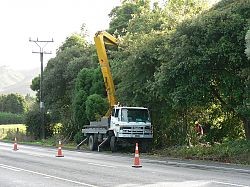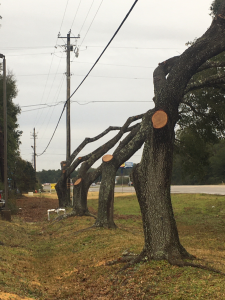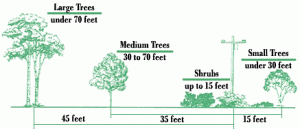With hurricane season upon us, evidence of preparation is all around us. Tree trimmers, contracted by the local electrical utility companies, have been removing trees, branches and other vegetation that is “too close” to power lines. Many homeowners are concerned over the practice.
In order to prevent power outages, the federally approved Vegetation Management Reliability Standard, FAC-033-2, requires utilities to manage vegetation growth along the path of power lines to prevent contact. A minimum clearance of fourteen (14) feet between trees and transmission lines in the right-of-way must be maintained at all times in order to achieve service reliability and public safety.
By Florida Statute 163, an electric utility is granted easement or right-of-way on private property in order to build and maintain electric power lines. Vegetation maintenance allows for the mowing of vegetation within the right-of-way, removal of trees or brush within the right-of-way and selective removal of tree branches that extend within the right-of-way by the electric utility personnel, licensed contractors or International Society of Arboriculture (ISA) Certified Arborists. The choice of how to trim trees and manage vegetation growth near a power line (e.g. pruning, herbicides, or tree removal) is primarily made by the electric utility, subject to state and local requirements and laws, applicable safety codes, and any limitations or obligations specified in right-of-way agreements. An individual may contact the utility company to obtain a copy of the right-of-way agreement for their property.
Sometimes, it appears to some that excessive vegetation has been removed. But, remember the utility companies are required to maintain the appropriate clearance “at all times.” For example, in the summer, power lines sag as they expand from rising air temperatures and heavy use. Also, wind and future growth must be taken into account when determining where to prune. Electric utilities usually prune or remove vegetation to a distance greater than the minimum clearances to account for all these factors. However, in many instances, removal of the tree would be more aesthetically pleasing and could avoid leaving a hazardous tree in the landscape. But, that is not part of their contract. That decision must be made by the property owner.
Tree trimming around power lines may seem like a local issue, but vegetation growth also affects interstate transmission lines. The U.S. Department of Energy estimates that electric utility service interruptions cost businesses and communities tens of billions of dollars annually. Tree contact with transmission lines was the leading cause of the August 2003 blackout that affected 50 million people in the Northeastern United States and Canada. In fact, that particular blackout prompted Congress to pass the Energy Policy Act of 2005, which lead the Federal Energy Regulatory Commission (FERC) to establish the Vegetation Management Reliability Standard.
Should we have a storm that impacts Northwest Florida, remember that the clearing of trees and branches provides faster access for first responders, line repair crews, and other emergency service personnel. So, as you watch the preparation work being done, think about where you will be planting a tree so that it can reach full maturity without threatening power lines, therefore, not requiring “ugly pruning!”
The urban forest is much different from a natural forest. Trees often develop a form that is more susceptible to breakage when grown in developed commercial and residential environments. As a result, trees need preventive pruning to develop strong structure. Research and observation show that well pruned trees can create a more wind resistant urban forest.
Pruning to create stronger tree structure is an ongoing process. To minimize the likelihood of tree damage it is necessary to reduce the length of limbs with a weak attachment to the trunk and to balance the canopy by reducing the length of limbs on the side where weight is concentrated. Do not remove interior branches, as this concentrates foliage at the tips of branches and causes them to break in strong winds.
Limbs that are more than ½ the diameter of the trunk and multiple trunks of similar size must be reduced in order to form strong branch unions and eliminate co-dominant leaders. A reduction cut is pruned back to a smaller lateral branch. Good pruning cuts avoid cutting into the collar. The collar is the swollen area at the base of the branch where it joins the trunk. The tissue is rich in energy reserves and chemicals that hinder the spread of decay.
Preventative pruning only applies to woody tree species. Palms need fronds to protect the bud and provide nutrients for growth. Arborists report that results from previous storms revealed that palms that had been “hurricane pruned” suffered more damage than those that were not pruned. Do not wait until the last minute to prepare your trees for hurricane season. Take action now. For more information on pruning visit: http://hort.ifas.ufl.edu/woody/pruning.shtml.
If you want professional help evaluating your trees or performing the proper corrective actions, visit: https://www.treesaregood.org/findanarborist to locate a Certified Arborist working in your area.
- Watch for “Melting Grass” - February 19, 2025
- Palms Can Suffer in the Cold - January 30, 2025
- Camellia Care - January 9, 2025



